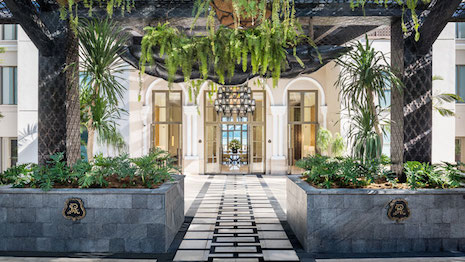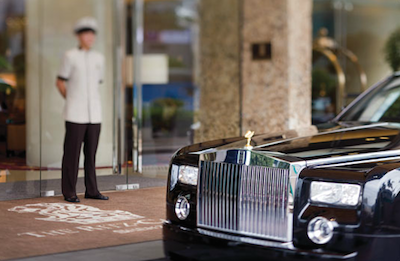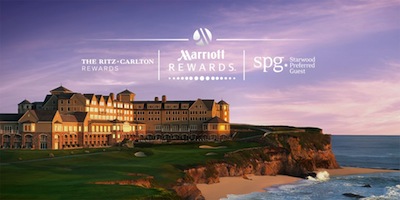 Lobby entrance at the St. Regis Langkawi, Malaysia
Lobby entrance at the St. Regis Langkawi, Malaysia NEW YORK – Since forming the world’s largest hospitality brand in fall 2016, Marriott International has added significantly to its luxury portfolio and has additional high-end properties in the pipeline.
On March 1, Marriott held a luncheon to discuss its merger with Starwood Hotels & Resorts, an acquisition that was the industry’s biggest news of 2016 and a significant milestone for Marriott in its 90-year history. Now that Starwood brands are under the Marriott umbrella, the latter hotelier counts The St. Regis, The Luxury Collection, W Hotels and others within its stable.
“I often refer to the merge as the perfect marriage … the operational excellence and execution prowess of Marriott International with the branding and marketing genius of Starwood makes for a perfectly balanced whole,” said Tina Edmundson, global brand officer at Marriott International.
Mindset
On Sept. 23 Marriott completed its acquisition of Starwood for approximately $12.2 billion, a deal that formed the world’s largest hotel conglomerate (see story).
Now operating as one entity, Marriott controls eight luxury brands with a presence in 65 different countries. Its global footprint allows Marriott the opportunity to serve guests all over the world, whether that means a party atmosphere or a more relaxing retreat.
Marriott’s extensive presence also provides the hospitality conglomerate with the ability to truly understand the changing needs and expectations of the luxury consumer. Having properties in all different locales, with varying experiences allows Marriott to appropriately respond to consumer behavior and interest.
Guests at St. Regis Tianjin, China
During her welcome address, Ms. Edmundson shared her thoughts on today’s luxury consumer, saying that guests who choose Marriott-owned properties are no longer as motivated by financial wealth as they once were. Increasingly, affluent guests are prioritizing time well-spent, relationships and personal happiness as success is measured differently.
Also, affluent guests are looking to shape their own vacations and the experience had, rather than the hotel dictating the expectations. Marriott has acknowledged guests’ interest in connection by adding value to its properties through experiential programming derived from a hotel location and the surrounding area’s culture.
“The affluent travelers in particular are not static … they are dynamic, forever changing and defined more by their interests and mindset than their geographic and demographic,” Ms. Edmundson said.
“We all know they are buying experiences over luxury goods … and this experience economy is good news for us … but we have to make sure we lead in terms of innovation, coupled with good, warm, genuine care for our guests,” she said.
Future footprints
As an answer to the booming experiential economy, Marriott has thoughtfully grown its brand portfolio’s footprint while making sure to preserve the identity, heritage and values of each banner.
Marriott’s main luxury players have upcoming property openings in nearly every corner of the globe.
The Ritz-Carlton, for instance, now has 93 hotels and has upcoming openings in destinations such as Langkawi, Malaysia, Astana, Kazakhstan and Geneva, among others. The brand will also open its fourth Ritz-Carlton Reserve property in Los Cabos, Mexico by the end of the year.
Known for its true, indigenous experiences, The Luxury Collection will debut nine properties in 2017. These include Napa Valley, CA, Singapore and Panama City, Panama.
The Ritz-Carlton Bahrain
The JW Marriott, inspired by the hotelier’s namesake founder, is an expression of “approachable, modern luxury.” The hotel brand currently counts 82 hotels in 28 countries, and in 2017 made its Vietnam debut with Vancouver, Tamuda Bay, Morocco and Jaipur, India to follow.
Marriott’s Bulgari Hotels & Resorts is also seeing growth with scheduled openings in Shanghai, Beijing and Dubai, United Arab Emirates in the second half of 2017.
After the completion of the merger, Marriott and Starwood also combined their loyalty programs to streamline their transition as separate companies into one conglomerate. Doing so provided loyalty guests greater flexibility in where they stay, opening up offers for more than 5,700 properties across the combined collection of hotels.
From October 2016, those who pay with a Starwood Preferred Guest by American Express card have been able to accrue points at Marriott Rewards hotels, while Chase Marriott Rewards and Ritz-Carlton Rewards Chase cardholders are able to do likewise at SPG participating properties (see story).
Marriott Rewards' landing site post-merger
In the coming months, Marriott will unveil a new loyalty program for its hotels. An innovative program is likely to keep recurring guests faithful to Marriott.
“We started off with a bang … offering our loyalty members the ability to link their accounts and status match one day one … which is only a sign of what’s to come,” Ms. Edmundson said.
“There’s a lot of work taking place behind-the-scenes and members will continue to see the results of it as we plan to introduce a new, single loyalty program in the future,” she said.


